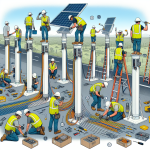Choosing the Right Solar Bollard for Your Needs
Table of Contents
Choosing the right solar bollard for your needs involves understanding various factors that influence their performance and suitability for different environments. Solar bollards are outdoor lighting fixtures powered by solar energy, making them an eco-friendly and cost-effective solution for illuminating pathways, gardens, driveways, and public spaces. When selecting a solar bollard, consider aspects such as the brightness level, battery capacity, solar panel efficiency, material durability, and design aesthetics. Additionally, evaluate the installation requirements and maintenance needs to ensure the bollard will function optimally in your specific location. By carefully assessing these criteria, you can select a solar bollard that not only meets your lighting needs but also enhances the overall ambiance and safety of your outdoor space.
Factors To Consider When Selecting Solar Bollards For Your Property
When selecting solar bollards for your property, several factors must be taken into account to ensure that you make an informed decision. The first consideration is the purpose of the solar bollards. Whether you need them for illuminating pathways, enhancing security, or adding aesthetic appeal, understanding the primary function will guide you in choosing the appropriate design and brightness level. For instance, bollards intended for security purposes may require higher lumens compared to those used merely for decorative purposes.
How to Select the Appropriate Location for Solar Bollard Lights?
To begin with, it is important to select the appropriate location for the solar bollard lights. The chosen site should receive ample sunlight throughout the day to ensure the solar panels can fully charge the batteries. Once the location is determined, the next step involves preparing the ground for installation. This typically requires digging a hole to secure the bollard firmly. It is advisable to follow the manufacturer’s guidelines regarding the depth and width of the hole to ensure stability.
How to Prepare for the Wiring Process?
After securing the bollard in place, attention must be turned to the wiring. Most solar bollard lights come with pre-installed wiring, but it is essential to verify that all connections are secure. Loose connections can lead to intermittent lighting or complete failure. Therefore, it is prudent to inspect the wiring thoroughly before proceeding. If the wiring is not pre-installed, it is necessary to connect the solar panel to the battery and the battery to the LED light. This usually involves connecting positive to positive and negative to negative terminals, ensuring a correct and secure connection.
How to Protect the Wiring from Environmental Factors?
In addition to securing the connections, it is vital to protect the wiring from environmental factors. Using waterproof connectors and insulating tape can prevent moisture ingress, which can cause corrosion and short circuits. Furthermore, it is advisable to bury the wiring underground or encase it in a protective conduit to shield it from physical damage. This not only prolongs the lifespan of the wiring but also enhances the overall safety of the installation.
How to Test the System Before Finalizing Installation?
Transitioning to the next critical aspect, it is essential to test the system before finalizing the installation. This involves checking the voltage levels of the battery and ensuring that the solar panel is charging correctly. A multimeter can be used to measure the voltage and current, providing a clear indication of the system’s performance. If any discrepancies are found, it is necessary to troubleshoot the connections and components to identify and rectify the issue.
What Are the Final Steps to Complete the Installation?
Once the system is tested and confirmed to be working correctly, the final step is to secure all components and tidy up the installation site. This includes backfilling the hole around the bollard and ensuring that all wiring is neatly arranged and concealed. It is also beneficial to perform a final inspection to ensure that all connections are secure and that there are no exposed wires.
Comparing Different Types Of Solar Bollards: Which One Is Best For You?
When it comes to selecting the right solar bollard for your needs, understanding the various types available and their respective advantages is crucial. Solar bollards, which are self-contained lighting units powered by solar energy, offer an eco-friendly and cost-effective solution for outdoor illumination. However, the diversity in design, functionality, and application can make the decision-making process somewhat complex. By comparing different types of solar bollards, you can determine which one best suits your specific requirements.
How to Choose Based on Purpose: Pathway vs. Decorative Solar Bollards
Firstly, it is essential to consider the primary purpose of the solar bollard. For instance, if you need bollards for pathway lighting, you might prioritize models that offer a broad and even light distribution. Pathway solar bollards are typically designed to provide sufficient illumination to ensure safety and visibility. They often feature a low-profile design and are equipped with diffused lenses to minimize glare. On the other hand, if the bollards are intended for decorative purposes in a garden or landscape, you might opt for models that emphasize aesthetic appeal. Decorative solar bollards come in various styles, from contemporary to classic, and often incorporate artistic elements such as intricate patterns or colored lenses.
Considerations for Brightness, Light Output, and Adjustability
Another critical factor to consider is the brightness and light output of the solar bollard. The light output is usually measured in lumens, and the required brightness will depend on the specific application. For high-traffic areas or commercial settings, bollards with higher lumen output are preferable to ensure adequate illumination. Conversely, for residential settings or areas where ambient lighting is sufficient, bollards with lower lumen output may be more appropriate. It is also worth noting that some solar bollards come with adjustable brightness settings, allowing you to customize the light output according to your needs.
Durability and Weather Resistance
Durability and weather resistance are paramount when comparing different types of solar bollards. Since these units are installed outdoors, they must withstand various environmental conditions, including rain, snow, and extreme temperatures. Look for bollards made from robust materials such as stainless steel, aluminum, or high-quality plastic. Additionally, ensure that the bollards have a high IP (Ingress Protection) rating, which indicates their resistance to dust and water. A higher IP rating signifies better protection against the elements, thereby enhancing the longevity of the bollard.
Energy Efficiency and Battery Life
Energy efficiency and battery life are other important considerations. Solar bollards rely on photovoltaic panels to capture sunlight and convert it into electrical energy, which is then stored in batteries. The efficiency of the solar panel and the capacity of the battery will determine how long the bollard can operate on a single charge. High-efficiency solar panels and long-lasting batteries are particularly beneficial in regions with limited sunlight or during winter months when daylight hours are shorter. Some advanced models also feature motion sensors or timers to optimize energy usage by activating the light only when needed.
Installation and Maintenance Considerations
Lastly, the ease of installation and maintenance should not be overlooked. Solar bollards are generally designed for straightforward installation, often requiring no wiring or trenching. However, some models may offer additional features such as adjustable height or interchangeable components, which can simplify the installation process and provide greater flexibility. Maintenance requirements vary depending on the design and materials used, but choosing bollards with replaceable batteries and easily accessible components can reduce long-term upkeep.
In conclusion, selecting the right solar bollard involves a careful evaluation of various factors, including the intended purpose, brightness, durability, energy efficiency, and ease of installation. By thoroughly comparing different types of solar bollards and considering your specific needs, you can make an informed decision that ensures optimal performance and satisfaction.
How To Assess The Quality And Durability Of Solar Bollards
When selecting the right solar bollard for your needs, it is crucial to assess the quality and durability of the product to ensure it meets your expectations and withstands the test of time. The first aspect to consider is the material used in the construction of the bollard. High-quality solar bollards are typically made from robust materials such as stainless steel, aluminum, or high-density polyethylene. These materials are known for their resistance to corrosion, impact, and harsh weather conditions, which are essential for outdoor installations.
In addition to the material, the design and engineering of the solar bollard play a significant role in its durability. Look for bollards that feature a sturdy, well-constructed design with reinforced joints and a solid base. This ensures that the bollard can withstand physical impacts and remain stable in various environmental conditions. Furthermore, the quality of the solar panel integrated into the bollard is paramount. High-efficiency solar panels made from monocrystalline or polycrystalline silicon are preferred due to their superior energy conversion rates and longevity.
Another critical factor to evaluate is the battery life and capacity of the solar bollard. The battery is responsible for storing the energy harnessed by the solar panel and powering the light during nighttime. Lithium-ion batteries are commonly used in high-quality solar bollards because of their long lifespan, high energy density, and low maintenance requirements. It is advisable to check the battery specifications, including its capacity and expected lifespan, to ensure it can provide consistent performance over an extended period.
Moreover, the type of light source used in the solar bollard is an important consideration. Light-emitting diodes (LEDs) are the preferred choice for most solar bollards due to their energy efficiency, long lifespan, and bright illumination. When assessing the quality of the LEDs, consider their lumen output, color temperature, and beam angle. High-quality LEDs will provide adequate illumination while consuming minimal energy, thereby extending the battery life.
The ingress protection (IP) rating of the solar bollard is another essential aspect to consider. The IP rating indicates the level of protection the bollard has against dust and water ingress. For outdoor applications, a minimum IP rating of IP65 is recommended, which ensures that the bollard is dust-tight and can withstand water jets from any direction. This level of protection is crucial for maintaining the functionality and longevity of the solar bollard in various weather conditions.
Additionally, it is beneficial to consider the warranty and customer support offered by the manufacturer. A comprehensive warranty indicates the manufacturer’s confidence in the quality and durability of their product. It also provides peace of mind, knowing that you are covered in case of any defects or issues. Reliable customer support is equally important, as it ensures that you can receive assistance and resolve any problems promptly.
Lastly, it is advisable to read reviews and testimonials from other users who have installed the same solar bollards. Their experiences can provide valuable insights into the performance, reliability, and durability of the product. By considering these factors and conducting thorough research, you can make an informed decision and choose a solar bollard that meets your needs and stands the test of time.
Read more about Solar Bollards:
- Introduction to Solar Bollards
- How Do Solar Bollards Work?
- Design and Aesthetics of Solar Bollards
- Maintenance and Durability of Solar Bollards
- Installation and Wiring of Solar Bollards
- Integration of Solar Bollards with Smart Technology
- Comparison of Solar Bollards with Traditional Lighting Solutions
- Regulations and Standards for Solar Bollards








